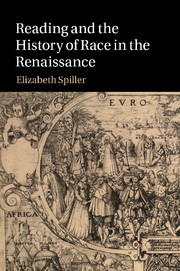Book contents
- Frontmatter
- Contents
- Acknowledgements
- Introduction: Print Culture, the Humoral Reader, and the Racialized Body
- 1 Genealogy and race after the Fall of Constantinople: From The King of Tars to Tirant lo Blanc and Amadis of Gaul
- 2 The form and matter of race: Aethiopika, hylomorphism, and neo-Aristotelian readers
- 3 The conversion of the reader: Ariosto, Herberay, Munday, and Cervantes
- 4 Pamphilia's black humor: reading and racial melancholy in the Urania
- Notes
- Index
3 - The conversion of the reader: Ariosto, Herberay, Munday, and Cervantes
Published online by Cambridge University Press: 01 June 2011
- Frontmatter
- Contents
- Acknowledgements
- Introduction: Print Culture, the Humoral Reader, and the Racialized Body
- 1 Genealogy and race after the Fall of Constantinople: From The King of Tars to Tirant lo Blanc and Amadis of Gaul
- 2 The form and matter of race: Aethiopika, hylomorphism, and neo-Aristotelian readers
- 3 The conversion of the reader: Ariosto, Herberay, Munday, and Cervantes
- 4 Pamphilia's black humor: reading and racial melancholy in the Urania
- Notes
- Index
Summary
Jacques Amyot presented his translation of Heliodorus' Aethiopika in part out of his concern about what might happen to those who read romances such as Amadis. Despite Amyot's efforts, sixteenth-century readers of Amadis were many. As different versions of the Amadis cycle circulated across Europe and into the New World, in hundreds of editions, large numbers of readers encountered these volumes: Marian Rothstein estimates as many as 500,000 sixteenth-century readers for the French editions alone.
The impact that the Amadis cycle had as it was introduced into print culture by Montalvo and then adapted and transmitted into other vernacular contexts was considerable. Winfried Schleiner characterizes the Amadis cycle as “the most influential work of prose fiction of the sixteenth century.” Publication details and physical states of existing copies make clear that these volumes were among the most widely published and read texts of the period. It is likely that a version of Books 4 and 5, which represent Montalvo's most radical reworking of the manuscript materials that he inherited, was printed first, before the other parts of the cycle, sometime in the 1490s. It is not until after Montalvo's death, though, that we see a strong and constant demand for new editions in the Spanish markets: between 1508, the date of the earliest extant edition of the first four books, and 1540, the date of the first Janot edition in France, there are almost a dozen Spanish editions.
- Type
- Chapter
- Information
- Reading and the History of Race in the Renaissance , pp. 112 - 152Publisher: Cambridge University PressPrint publication year: 2011



